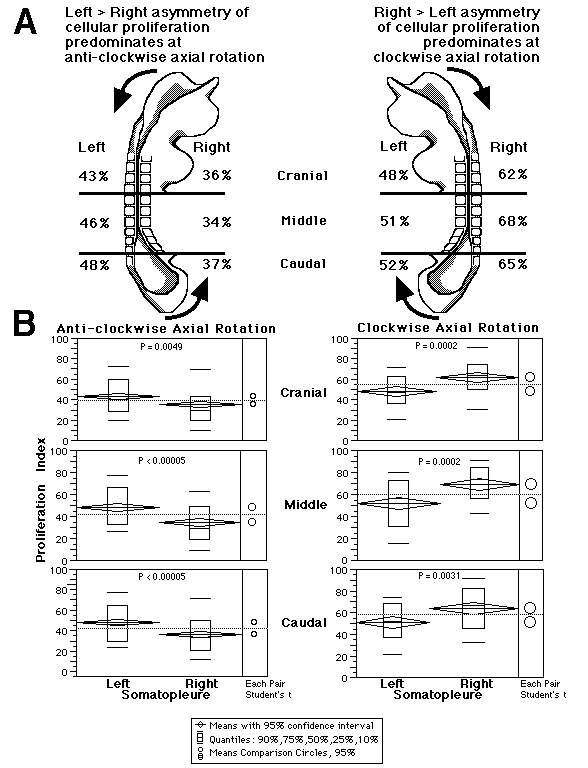Right-Left Asymmetry of Cell
Proliferation Predominates in Mouse Embryos Undergoing Clockwise
Axial Rotation
Sue Ann Miller and Richard D. White
Department of Biology, Hamilton College, Clinton, New York
Abstract
Anatomical Record 250:103-108 (1998)
Background: Differential growth is fundamental to most
mechanisms proposed for axial rotation in amniotes. Other mechanisms,
such as changes in cell shape are not consistently suggested by
ultrastructure. Lateral asymmetries in cell proliferation exist in
mouse and chick embryos undergoing normal, anti-clockwise axial
rotation, but there has been no investigation of inverse, clockwise
rotation, that could test the correlation.
Methods: We used the BALB/cHu - iv/iv, situs
inversus mouse to test apparent correlation of lateral
asymmetries with morphogenesis that we saw in cell division patterns
of normally rotating mice. Proliferation indices were collected from
tritium autoradiograms.
Results: Asymmetry of cell proliferation in inverse axial
rotation is a mirror image of the pattern seen for normal axial
rotation: right predominates over left. This asymmetry is
statistically significant and correlates with morphology. Patterns of
proliferation in constraining extraembryonic membranes, particularly
visceral yolk sac, suggest that rotation could be pushed by uneven
lateral growth as body and gut tubes form, for they are attached to
these membranes.
Conclusions: Data from iv/iv mice provide additional
evidence that differential growth, constrained by contiguous
extraembryonic membranes, may drive closure of body and gut walls and
contribute to axial rotation. Asymmetries of cell proliferation are
likely consequences of genetic cascades, and will need to be
incorporated with in situ information on gene activity.
Grant sponsor: Margaret Bundy Scott Fund;
Grant sponsor: The Hamilton College Faculty Research Fund.
|
Summary Figure: Left-right asymmetry of cellular
proliferation predominates at anti-clockwise axial rotation
whereas right-left asymmetry of cellular proliferation
predominates at clockwise axial rotation. Data represent 18
embryos from 10 litters of two randomly outbred stains of
mice and 5 embryos from 4 litters of BALB/cHu - iv/iv. Data
were collected from 50,089 cells in Theiler (1972) stages 12
to 15 (4 to 25 somite pairs). A. Schematics present
composite data from somatopleure in rotating embryos.
B. Statistical analyses of proliferation indices from
somatopleure of the groups of embryos schematized in part A.
Quantiles (90%, 75%, 50%, 25%, 10%) are shown by lines and
boxes. Diamonds and circles indicate means with 95%
confidence interval. Flatter diamonds and smaller comparison
circles indicate greater confidence in a mean from a larger
sample. Comparison circles that do not overlap indicate
significantly different sets of data.
|
|

|
Normal mouse endoderm shows different
asymmetries.
to SAMiller's research page
to SAMiller's publications
to SAMiller 's homepage


Last Modified: 31 October 1999
